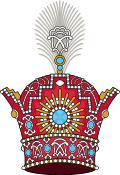
Back Sjah Afrikaans Xah AN شاه Arabic شاه ARZ Xa AST Şah Azerbaijani شاه (عونوان) AZB Шаһ Bashkir Шах Byelorussian Шах (титла) Bulgarian
This article needs additional citations for verification. (February 2024) |

| Part of a series on |
| Imperial, royal, noble, gentry and chivalric ranks in West, Central, South Asia and North Africa |
|---|
 |
Shah (/ʃɑː/; Persian: شاه [ˈʃɒːɦ] ⓘ – lit. 'king') is a royal title that was historically used by the leading figures of Iranian monarchies.[1] It was also used by a variety of Persianate societies, such as the Ottoman Empire, the Khanate of Bukhara, the Emirate of Bukhara, the Mughal Empire, the Bengal Sultanate, historical Afghan dynasties, and among Gurkhas.[2] Rather than regarding himself as simply a king of the concurrent dynasty (i.e. European-style monarchies), each Iranian ruler regarded himself as the Shahanshah (شاهنشاه [ʃɒːhænˈʃɒːɦ] – lit. 'King of Kings') or Padishah (پادشاه [pʰɒːdeˈʃɒːɦ] – lit. 'Master King') in the sense of a continuation of the original Persian Empire.

- ^ Yarshater, Ehsan Persia or Iran, Persian or Farsi Archived 2010-10-24 at the Wayback Machine, Iranian Studies, vol. XXII, no. 1 (1989)
- ^ Siddiq, Mohammad Yusuf (Spring–Summer 2015). "Titles and Islamic Culture as Reflected in the Islamic Architectural Inscriptions of Bengal (1205–1707)". Islamic Studies. 54 (1/2): 50–51. JSTOR 44629923.
Shāh ... [a] Persian title, ... sometimes in different compound forms, such as Bādshāh or Pādshāh ... stands for monarch, which has become part of the popular vocabulary over years in a number of South Asian languages including Bengali, Urdu and Hindi, in addition to the languages of neighbouring regions. The last Afghan king Zāhīr Shāh, for instance, used to be called "Bādshāh" until his dethronement in 1973. Used by all the Mughal emperors in India, the title appeared in a few [Bengal] Sultanate inscriptions as well.